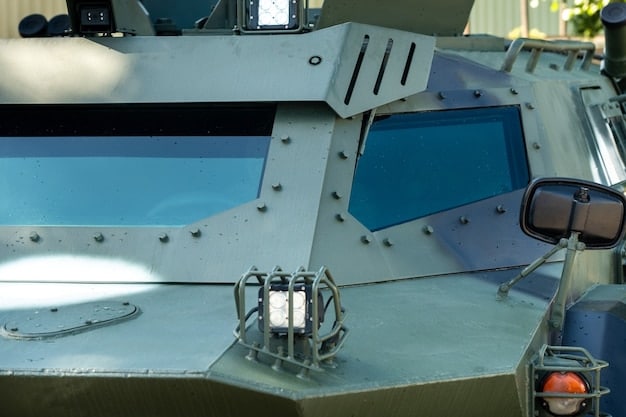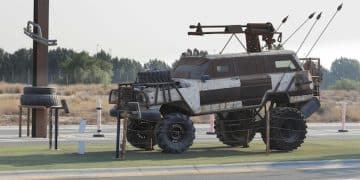US Navy Laser Weapons: 2025 Performance and Deployment Analysis

The US Navy’s Laser Weapon Systems in 2025 represent a significant leap in naval warfare technology, offering enhanced precision, reduced costs per engagement, and a potent defense against asymmetric threats like drones and small boats, transforming maritime security strategies.
The US Navy’s Laser Weapon Systems: A 2025 Performance and Deployment Update promises a transformative shift in naval warfare. As the clock ticks towards 2025, the anticipation surrounding these advanced directed energy weapons (DEWs) grows, signaling a new era in maritime defense. Will these systems live up to the hype?
The Dawn of Directed Energy Weapons in the US Navy
The integration of directed energy weapons (DEWs) like lasers into the US Navy’s arsenal marks a paradigm shift in naval warfare. These systems offer a range of advantages over traditional kinetic weapons, promising to revolutionize how the Navy engages with threats.
But what exactly makes these laser weapons so appealing, and how far has the Navy progressed in their development and deployment?
Advantages of Laser Weapon Systems
Laser weapons offer several key advantages, making them a desirable addition to the Navy’s arsenal. These include precision targeting, scalability, and a potentially lower cost per engagement.
Challenges in Deployment
Despite the advantages, deploying laser weapon systems is not without its challenges. These include environmental factors, power and cooling requirements, and the need for robust training and maintenance programs.

- Precision Targeting: Lasers can engage targets with pinpoint accuracy, minimizing collateral damage.
- Scalability: The power output of laser weapons can be adjusted to match the threat, from disabling sensors to destroying targets.
- Cost-Effectiveness: Over the long term, lasers can offer a lower cost per engagement compared to traditional missiles or gun rounds.
The US Navy’s commitment to DEWs is evident through ongoing research, development, and testing programs. As technology matures and deployment hurdles are overcome, laser weapons are poised to become a mainstay of naval defense.
Key Laser Weapon Systems in Development
Several laser weapon systems are currently in various stages of development and testing for the US Navy. These systems represent a diverse range of capabilities, designed to address different threats and operational scenarios.
Let’s take a closer look at some of the most promising laser systems and their potential impact on naval warfare.
The High Energy Laser and Integrated Optical-dazzler and Surveillance (HELIOS)
HELIOS is a major step forward in integrating laser weapon technology onto existing warships. This system combines a high-energy laser with intelligence, surveillance, and reconnaissance (ISR) capabilities.
The Solid State Laser Technology Maturation (SSL-TM) Program
The SSL-TM program focuses on developing more compact and efficient solid-state lasers. This program aims to overcome challenges related to size, weight, and power (SWaP) constraints on naval vessels.

- HELIOS Integration: The integration of HELIOS onto Arleigh Burke-class destroyers signifies a major capability upgrade for these warships.
- SSL-TM Advancements: The SSL-TM program is paving the way for more powerful and versatile laser systems in the future.
- Counter-UAS Capabilities: Many of these systems are designed to counter unmanned aerial systems (UAS), also known as drones, which pose an increasing threat to naval assets.
These laser weapon systems represent a significant investment in the future of naval warfare. As they continue to evolve, they will provide the US Navy with a powerful and versatile tool for defending its ships and interests around the globe.
Performance Expectations for 2025
As 2025 approaches, expectations are high for the performance and deployment of US Navy laser weapon systems. While it is unlikely that lasers will completely replace traditional weapons, they are expected to play an increasingly important role in naval defense.
What specific capabilities can we anticipate seeing from these systems in the near future?
Enhanced Counter-Drone Capabilities
One of the most immediate benefits of laser weapons is their ability to effectively counter drone threats. Lasers can disable or destroy drones at a fraction of the cost of traditional interceptors.
Defense Against Small Boats and Swarm Attacks
Laser weapons also offer a potent defense against small boat threats and swarm attacks. Their precision and rapid engagement capabilities make them well-suited for countering these types of asymmetric threats.
- Drone Defense: Expect to see laser systems deployed to protect naval vessels from drone attacks, providing a cost-effective and reliable form of defense.
- Small Boat Interdiction: Lasers can be used to deter or disable small boats engaged in hostile activities, enhancing maritime security.
- Sensor Dazzling: Lower-power lasers can be used to temporarily blind or disrupt enemy sensors, providing a non-lethal means of disrupting their operations.
The US Navy’s laser weapon systems are expected to demonstrate improved performance and reliability by 2025. These advancements will enable the Navy to confidently deploy these systems in a wider range of operational scenarios.
Deployment Plans and Operational Integration
The successful deployment of laser weapon systems requires careful planning and integration into existing naval operations. This includes addressing logistical challenges, developing training programs, and establishing clear rules of engagement.
How is the US Navy approaching the deployment and operational integration of these advanced weapons?
Ship Integration and Modifications
Integrating laser weapon systems onto naval vessels often requires significant modifications to the ship’s power and cooling systems. Careful planning is essential to ensure that these systems can be effectively supported.
Training and Doctrine Development
Sailors must be properly trained to operate and maintain laser weapon systems. New training programs and operational doctrines are needed to effectively integrate these weapons into naval warfare.
- Power Upgrades: Many existing warships will require power upgrades to support the energy demands of laser weapons.
- Cooling Systems: Effective cooling systems are essential to prevent overheating and ensure the reliable operation of laser weapons.
- Crew Training: Sailors will need specialized training to operate and maintain these advanced weapons, including skills in laser safety, targeting, and system diagnostics.
The US Navy is committed to a phased approach to deploying laser weapon systems, starting with integration on select platforms and gradually expanding to a wider range of ships as technology matures and operational experience is gained.
Technological Advancements Driving Progress
Several key technological advancements are driving progress in laser weapon systems. These include improvements in laser power efficiency, beam control, and atmospheric compensation.
Let’s delve into some of the technological breakthroughs that are making laser weapons a reality for the US Navy.
Solid-State Laser Technology
Advancements in solid-state laser technology have enabled the development of more compact and efficient laser systems. These lasers are better suited for integration onto naval vessels.
Adaptive Optics and Beam Control
Adaptive optics and advanced beam control systems compensate for atmospheric distortions, allowing lasers to maintain their accuracy and effectiveness over long distances.
- Power Efficiency: Higher power efficiency means that laser systems can generate more energy with less input, reducing their logistical footprint.
- Beam Stability: Precise beam control is essential for maintaining accuracy and preventing collateral damage.
- Atmospheric Compensation: Adaptive optics systems can correct for atmospheric turbulence, ensuring that the laser beam reaches its target with minimal distortion.
The US Navy continues to invest in research and development to push the boundaries of laser technology. These investments will lead to even more capable and effective laser weapon systems in the years to come.
Future Outlook and Potential Impact
The future of laser weapon systems in the US Navy looks promising. As technology matures and deployment experience grows, lasers are expected to become an increasingly integral part of naval warfare.
What is the long-term outlook for laser weapons, and what impact could they have on naval strategy and operations?
Transforming Naval Warfare
Laser weapons have the potential to transform naval warfare by providing a more precise, scalable, and cost-effective means of engaging threats. They can also enhance the defensive capabilities of naval vessels.
Shaping Future Naval Strategy
The integration of laser weapons will likely influence future naval strategy, leading to new tactics and operational concepts. Lasers offer a unique combination of capabilities that can be leveraged in a variety of scenarios.
- Enhanced Defense: Laser weapons can provide a robust defense against missiles, drones, and other threats, increasing the survivability of naval vessels.
- Strategic Deterrence: The presence of laser-equipped warships can serve as a deterrent to potential adversaries, signaling the US Navy’s commitment to maintaining maritime superiority.
- Asymmetric Warfare: Lasers can be particularly effective in asymmetric warfare scenarios, where they can be used to counter smaller, agile threats like small boats and drones.
The US Navy’s continued investment in laser weapon systems underscores its belief in the transformative potential of this technology. As lasers become more prevalent, they will play an increasingly important role in shaping the future of naval warfare.
| Key Point | Brief Description |
|---|---|
| 🎯 Precision Targeting | Pinpoint accuracy minimizes collateral damage in engagements. |
| 🛡️ Counter-Drone Defense | Effective against UAVs, offering a low-cost intercept solution. |
| ⚡ Scalable Power | Adjustable laser power for various threats and engagement levels. |
| 🚢 Ship Integration | Upgrades to ship systems needed for power and cooling requirements. |
Frequently Asked Questions
▼
Laser weapon systems offer precision targeting, scalability, and a potentially lower cost per engagement compared to traditional kinetic weapons. They are also effective against asymmetric threats.
▼
HELIOS (High Energy Laser and Integrated Optical-dazzler and Surveillance) is a laser weapon system being integrated onto US Navy warships, combining a high-energy laser with ISR capabilities.
▼
Challenges include environmental factors, power and cooling requirements, and the need for robust training and maintenance programs for naval personnel operating the advanced laser technology.
▼
Laser weapons can disable or destroy drones at a fraction of the cost of traditional interceptors, providing a more cost-effective and reliable form of defense against aerial threats.
▼
Key advancements include solid-state laser technology, adaptive optics, and advanced beam control systems. These allow more compact, efficient, and accurate laser deployments on naval vessels.
Conclusion
The US Navy’s laser weapon systems represent a major step forward in naval warfare. As these systems continue to develop and deploy, they will provide the Navy with enhanced capabilities for defending against a wide range of threats, shaping the future of maritime security.





